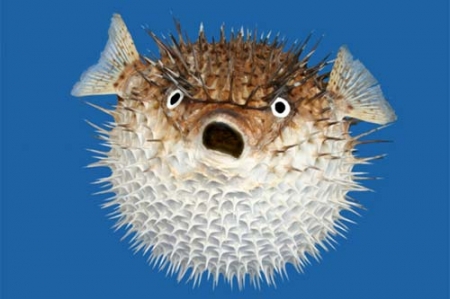Mushrooms.

Most people know that certain types of mushrooms can be deadly. The more common poisonings come from the Death Cap (often confused for the Paddy Straw mushroom), Destroying Angels, and Deadly Webcap. Death Caps alone contain over seven toxins and one bite can lead to a nasty death. Watch out for the Gyomitra, which is often confused for Morrel.
Blowfish (Fugu).

This fish is deadly on its own, and highly regarded as a Japanese and Hong Kong delicacy. It’s poison, tetrodotoxin, is 1,200 times more potent than cyanide. Around one hundred diners die each year from it. Preparation is the key; make sure a licensed chef prepares your Fugu. Becoming a licensed Fugu chef is a long and intensive process, culminating in the chef preparing a Fugu meal and eating it himself. The most deadly parts of Fugu include the liver, muscles, ovaries, and skin.
Shellfish.

Shellfish poisoning is mostly associated with bivalve mollusks (mussels, clams, oysters, and scallops). These shellfish are filter feeders and can accumulate high levels of toxics including domoic acid, produced by microscopic algae. Cooking doesn’t always inactivate these toxins and some can lead to death in high dosages. Kosher diets anyone?
Rhubarb.

Ever wonder why Rhubarb recipes mostly contain the stem and not the leaves? The leaves contain higher concentrations of oxalate, which causes poisoning in large doses. The stems contain much less of the compound. Anthraquinone glycosides are also present and may add to its toxicity.
Potatoes.
Potatoes contain glycoalkaloids (solanine and chaconine), toxic compounds which are more prevalent in the wild potato varieties. Cooking at high temperatures mostly removes the toxin, although headaches, diarrhea, and cramps—and in severe cases, coma and death—can occur in rare cases. Ever wonder why we’re told to keep potatoes away from light? It’s to prevent higher concentrations of solanine. So don’t eat potatoes after they have turned green.
Apricot Stones (Seeds).

Actually, many fruits of the rose family contain cyanogenetic glycosides, which upon ingestion release hydrogen cyanide gas. These include seeds from cherries, apples, plums, almonds, and peaches. Although it would take a mega-dose to do you in, keep this in mind the next time you go on an apricot seed binge. There have been reported deaths in Turkey, a large apricot grower, for this very reason.
Tomato.
Although the fruit itself is safe (more technically a berry), tomato plants contain glycoalkaloids, which are indeed toxic.
Chocolate.
Chocolate contains the alkaloid theobromine, which in unusually high doses can be toxic to humans. However, it would take an unholy amount of chocolate to achieve this. But other species react much worse: dogs, parrots, horses, and cats can be killed by ingesting chocolate.
Tapioca.
Tapioca, if not processed properly, can be toxic. It contains a natural source of cyanide, whose precursor, linamarin, is rendered harmless if properly dried, soaked, and baked.
Peanuts.
Our little top hat and spectacle friends can be deadly for those allergic, which isn’t all that uncommon. Watch out for artificially flavored nuts as well; they can be re-flavored with another kind of nut that you might be allergic to.